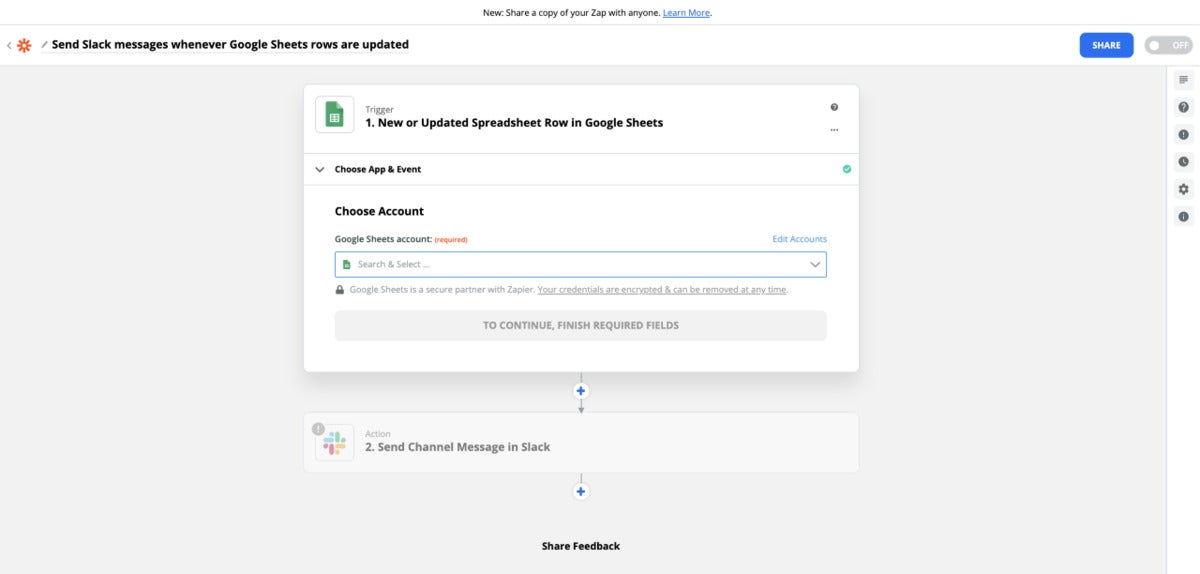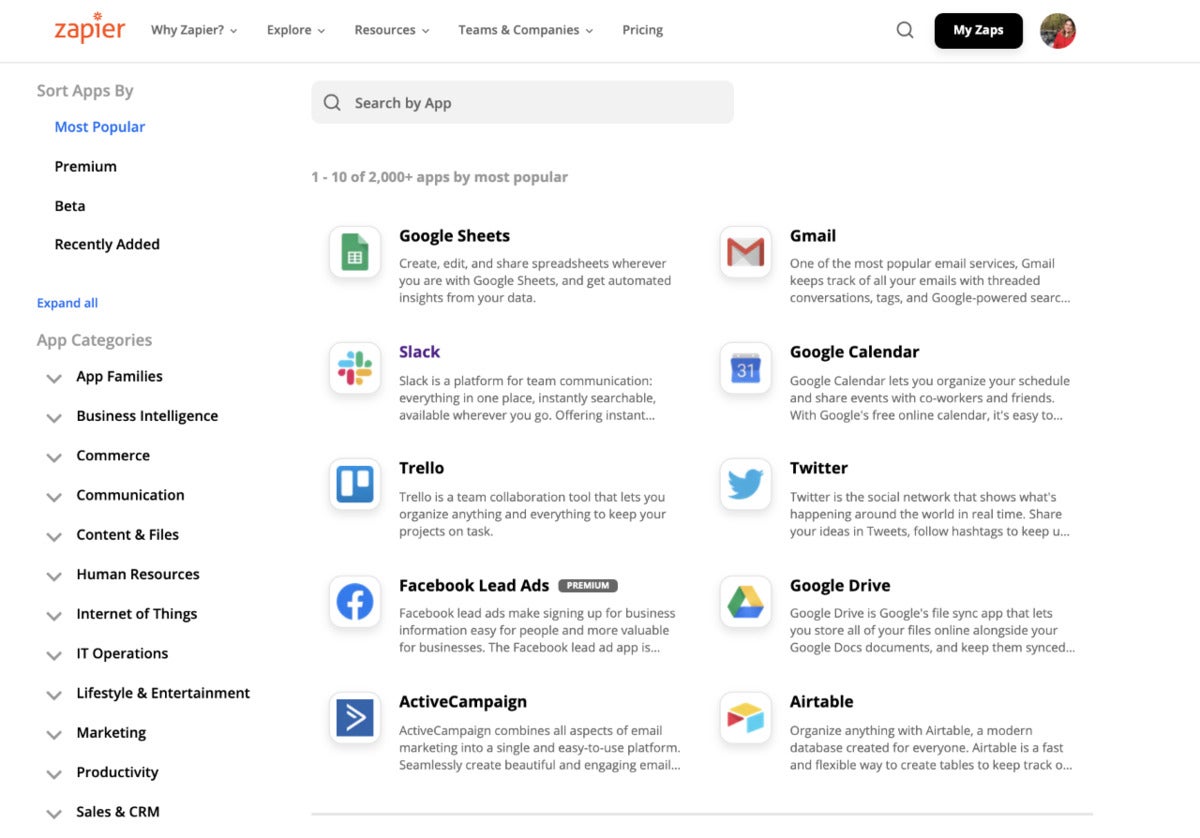As more and more work processes become digitized through the use of cloud applications, companies are finding it easier to automate mundane and repetitive tasks. Uploading files, creating calendar events and sending text messages to colleagues may seem trivial in isolation, but they can add up — taking away time and attention from more useful tasks.
“One of the biggest advantages of automation in the workplace is time savings,” said Wade Foster, CEO of workflow automation platform Zapier. The Sunnyvale, CA-based software firm has attracted some 1.8 million paid and free users since its launch in 2011, and claims its tools save users an average of 10 hours a week.
 Zapier
ZapierZapier CEO Wade Foster.
Zapier users can connect workflows across more than 2,000 apps, ranging from Microsoft Outlook, Excel and Dynamics CRM to Google’s various collaboration and productivity tools, and others such as Slack, Trello and Dropbox. There are various line-of-business applications, too — in particular, sales and marketing platforms such as Salesforce, Zoho CRM and HubSpot.
In essence, Zapier aims to make it easier for workers to connect workflows across web apps using code-less automations, regardless of technical expertise. The no-code approach is also designed to lighten the load on IT staff.
“The advantages of personal workflow automation/citizen integrator tools are improved employee productivity and a reduced burden on central IT for relatively trivial integration/automation projects,” said Keith Guttridge, senior director analyst covering application architecture, infrastructure and integration at Gartner.
How does Zapier work?
Zapier relies on an intuitive interface that lets users set up “if this, then that” (IFTTT) rules that govern how its automations function. These are called “zaps,” and consist of a “trigger” — an event such as receiving an email or a sales lead — and one or more “actions,” which could be the creation of a contact in a spreadsheet.
Zapier users can, for example:
- Update Salesforce when new leads are added to a Google Sheets spreadsheet;
- Create a task in project management app Asana by saving a message in Slack;
- Add subscribers to a mailing list Mailchimp when they sign up for a newsletter.
Creating a workflow is straightforward. The easiest option is to choose from among templates available in the Zapier app’s Dashboard and Explore section, which allow users to start with popular automations such as “Add new leads to my CRM or support platform” and “Share content across social media.”
Users can also create custom zaps. To do so, first select an app that will function as the workflow trigger, connect to the app account, and then choose a trigger “event” – what is supposed to occur in the selected app to run the zap. Next, select the app to perform the action and the event to be triggered.
 Zapier
ZapierTriggers can be set up to react to events, such as new rows being added to a Google Sheets spreadsheet.
It’s also possible to create multi-step zaps that perform several actions, all tied together in a string triggers and actions. That flexibility opens the door to a variety of automations (though many of Zapier’s more popular use cases now center around sales and marketing).
 Zapier
ZapierEach trigger leads to one or more actions, such as notifying team members in Slack of changes to a spreadsheet.
Before a zap is activated, it can be customized further with the addition of extra steps such as actions, filters to restrict zaps from running under certain conditions, delays between steps, and more. Workflows can then be tested to ensure they work as expected before being rolled out.
Once live, zap activity can be tracked in the Task History in the Zapier app.
How do businesses use Zapier?
In addition to using Zapier to connect workflows, companies have turned to it for help during the COVID-19 pandemic. Foster said his company has helped smaller firms move their business online quickly, connecting and updating various applications such as CRM records. (Zapier’s own workforce is already fully remote, pre-dating the COVID-19 pandemic and giving it insights on how automation tools can connect multiple cloud apps.)
“Many small business owners don’t have the technical expertise or someone on staff that can build these sites for them,” he said. “So they turn to no-code tools to create professional websites, and built automations with Zapier to reach new customers, manage inventory, and ensure leads didn’t slip through the cracks.”
Saving employees time spent on repetitive tasks is a common benefit, said Andrew Davison, founder of Luhhu, a UK-based workflow automation consultancy and Zapier expert. He pointed to the amount of time wasted when workers have to key in the same data in different systems; that situation is only getting worse as businesses rely on more and more apps.
“Zapier can eliminate this, meaning staffing costs can be reduced outright, or staff can be redeployed to more meaningful, growth-orientated work,” he said. “And human error with data entry is avoided — which can definitely be an important thing for some businesses in sensitive areas — like legal, for example.”
 Zapier
ZapierZaps are available for a range of purposes, from automating personal productivity workflows to social media posts.
Zapier pricing
There are five Zapier pricing tiers, offering access to various features at differing levels. Costlier tiers remove restrictionson usage and raise caps on the number of zaps and “tasks” that can be carried out (tasks means the number of times an action is completed, so a single zap with three actions uses three tasks from the monthly quota each time it runs).
Users can create five single-step Zaps for free, with a limit of 100 tasks and access limited to single-step zaps. More complex Zaps require a monthly fee. For $19.99, users can connect 20 multi-step Zaps and perform 750 action “tasks” each month.
The $49 Professional tier removes the zap limit and ups the monthly task limit to 2,000. Professional customers also gain access to features such as filters and custom logic “paths” for more advanced, branching workflows. The $299/month Team plan provides a shared workspace, support for unlimited users and dedicated support.
That Company tier adds access to all premium features, 100,000 tasks and enterprise-grade admin features such as advanced permissions settings, single sign on and user provisioning. Pricing for this tier depends on the specific needs of each company and negotiated prices with Zapier.
Zapier and its automation rivals
Interest in workplace automation has risen sharply in recent years, said Guttridge, with demand rocketing for robotic process automation tools, for example, and personal productivity workflows.
Numerous software vendors are already focused on the market Zapier targets. IFTTT, for example, helped popularize codeless automations, though it skews more towards consumer uses, such as automating smart home devices. That said, it recently unveiled an IFTTT Pro option for users, indicating it wants a larger footprint in the automation world.
 Zapier
ZapierMore than 2,000 applications can be connected in Zapier to automated workflows.
Microsoft Power Automate (formerly Microsoft Flow) also connects various productivity and business applications to create automations, called “flows,” with an emphasis on its own range of software tools.
While Zapier is aimed mainly at small businesses looking to connect a variety of apps, automation options are available for larger enterprise workflows: Workato and Salesforce’s Mulesoft have been cited in Gartner’s Magic Quadrant for integration platforms as a service. And Tray.io and Okta’s Azuqua also offer a stronger enterprise bent.
In addition, the popularity of automation has led collaboration and productivity software firms such as Slack, Trello and Airtable to build rules-based automation natively into their platforms. While doing so provides the advantages of workflow automation, they’re largely targeted at processes within a single application.
A key strength for Zapier are its codeless automations. “Zapier is one of most well-known vendors in personal workflow automation/citizen integrator tooling and provides useful capabilities for its many users,” said Guttridge.
“Simply put, Zapier [was] the first … to do this (aside from IFTTT, but they quite long ago lost their way and fell out of fashion), so when people go looking on Google for “how to automate X” they’ll usually find Zapier,” said Luhhu’s Davison. “That said, other tools like Integromat and n8n are playing catchup. [Zapier’s] dominance might not be around forever.”
Foster argued that Zapier’s integration options put it ahead of rivals. “Regardless of whether you rely on well-known apps like QuickBooks or MailChimp, or smaller niche apps to run your business, chances are Zapier connects them,” he said.
While Zapier focuses on connecting cloud apps, there’s also significant business interest in connecting older on-premise applications. Expanding its focus in this regard could benefit Zapier, said Guttridge.
“Gartner clients regularly ask for Zapier-like tools to help create workflows involving legacy applications, so an opportunity awaits,” he said.



